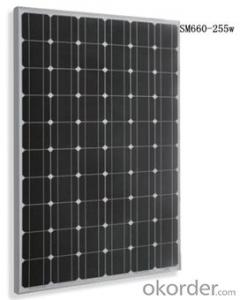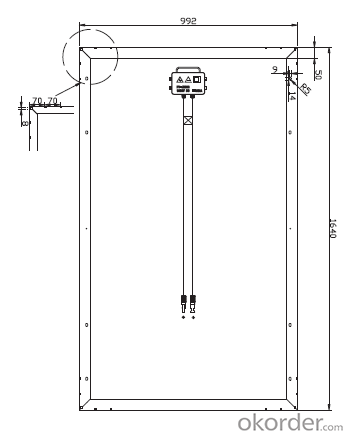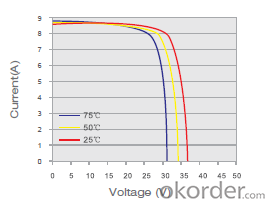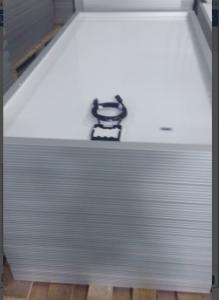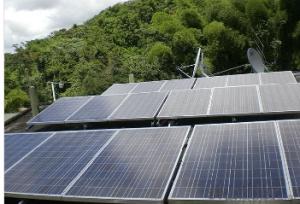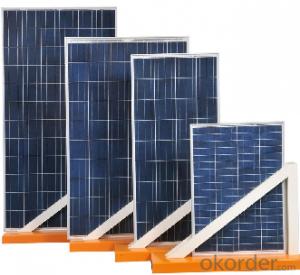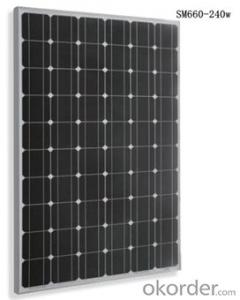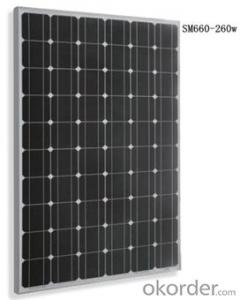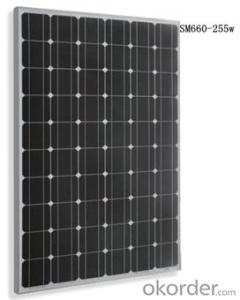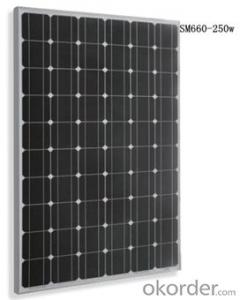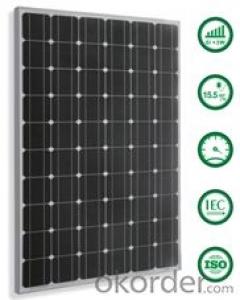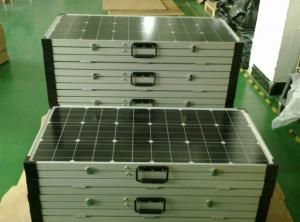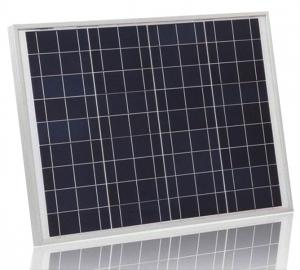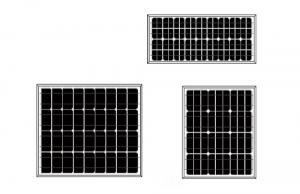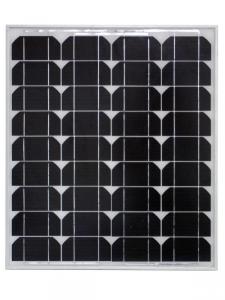NYC Solar Panels - Monocrystalline Solar Module Black SM660-255W
- Loading Port:
- Shanghai
- Payment Terms:
- TT OR LC
- Min Order Qty:
- 25 set
- Supply Capability:
- 8000 set/month
OKorder Service Pledge
OKorder Financial Service
You Might Also Like
Product Description:
1.Structure of Monocrystalline Solar Module SM660-255w Series Description:
Monocrystalline Solar Module SM660-255w: High efficiency crystalline solar cell. Even if under the weak light, the solar module can produce maximum power output.
II Tempered glass (toughened glass): Anti-reflecting coating and high transmission rate glass increase the power output and mechanical strength of solar module.
III EVA and TPT: Using high quality EVA and TPT to prevent destroying and water.
IV AI frame: Without screw, rner connection. 6 holes on the frame can be installed easily.
V Junction box: Multi function junction box with water proof.
VI Long lifetime: ≥25 years; Less power decrease.
VII Good performance of preventing from atrocious weather such as wind and hails.
VIII Resisting moisture and etching effectively, not effected by geology.
IX The certificate issued by international authority: TUV, IEC, CE.ISO9001.MCS
2. Characteristics of Monocrystalline Silicon Solar Panel:
• Guaranteed tolerance +3%
• High manufacture standards
• Reliable power output
• High module efficiency
• Module efficiency up to 15.5%
• Cells efficiency up to 17.6%
• Strong compressive strength
• Certified to withstand high wind of 2400Pa
3. Standard Test Conditions of Monocrystalline Silicon Solar Panel:
The opto-electrical specifications shown below are stabilized values being measured at Standard Test Conditions, Irradiance: 1000W/m2, Spectrum: AM1.5 at 25°C, The info below is subject to manufacturing tolerances. Where appropriate minutes of measurement are available and are used for the dimensioning of the installation.
Advantages of Polycrystalline Silicon Solar Panel
• 25 year transferrable power output warranty: 10 years / 90%, 25 years / 80%*
• 12 year material and workmanship warranty
• Timeliness of delivery
• Quality Products certified (TUV, IEC, CE.ISO9001.MCS)
4. Solar Panel Images
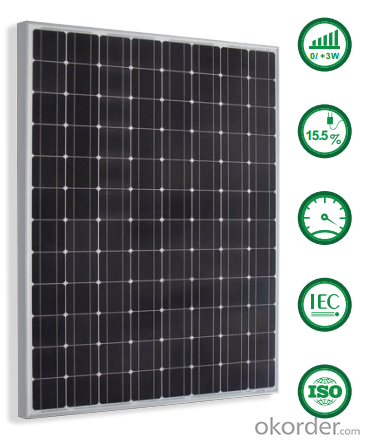
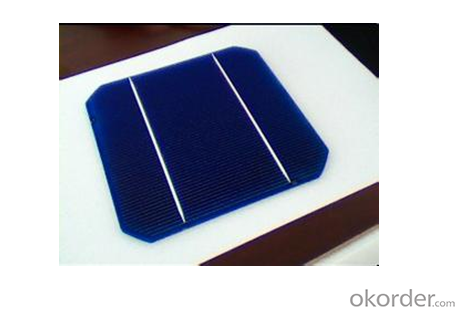


5. Monocrystalline Silicon Solar Panel Specification
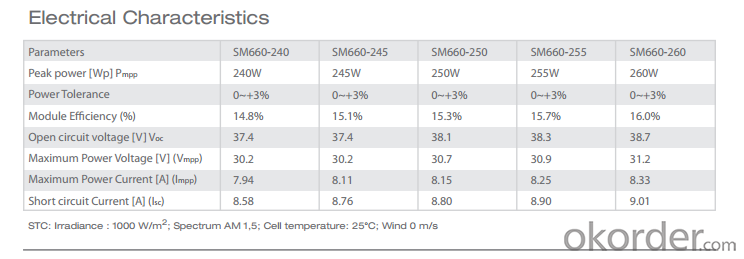
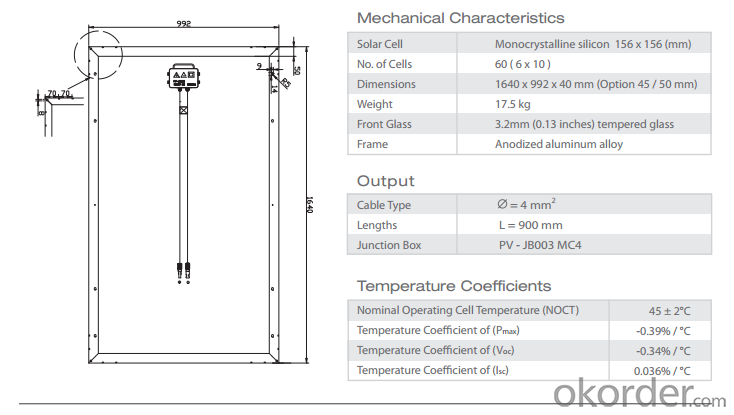


6.FAQ
We have organized several common questions for our clients,may help you sincerely:
①How about your company?
We are a private-owned high-tech company who specializes in developing, manufacturing and marketing of silicon ingots, solar wafer, solar cells, solar modules, PV systems and solar applications products.
At present, We has one research & development team, whose members are well-known experts in photovoltaic area. We also have advanced production and test equipment.
②How to guarantee the quality of the products?
Our products have been certified by CE, CEC,MCS, IEC61215, IEC61730 and ISO9001.
• 25 year transferrable power output warranty: 10 years / 90%, 25 years / 80%*
• 12 year material and workmanship warranty
• Timeliness of delivery
• Quality Products certified (TUV, IEC, CE.ISO9001.MCS)
③How long can we receive the product after purchase?
In the purchase of product within three working days, We will arrange the factory delivery as soon as possible. The pecific time of receiving is related to the state and position of customers.Commonly 7 to 10 working days can be served.
- Q: Can solar panels be installed on a restaurant or food establishment?
- Yes, solar panels can definitely be installed on a restaurant or food establishment. In fact, many restaurants and food establishments are increasingly adopting solar energy as a sustainable and cost-effective solution to power their operations. By installing solar panels, these establishments can reduce their carbon footprint and save on energy costs in the long run.
- Q: Can solar panels be installed on windows?
- Yes, solar panels can be installed on windows. There are specially designed solar window panels available that can be installed on the glass surface of windows to harness solar energy. These panels are transparent and allow light to pass through while generating electricity from the sunlight.
- Q: What is the average payback period for solar panels?
- The average payback period for solar panels typically ranges from 5 to 10 years, depending on various factors such as the initial cost of installation, local electricity rates, available incentives, and the amount of sunlight received in the area.
- Q: I contend:As far as the solar panels causing global warming I'll try to explain. If you put a black panel on the ground or on your house and don't connect it to anything, it will absorb solar energy (heat) during daylight and release it at night (radiation). The net heat gain is zero. If you hook up a solar panel in the same place but hook it up to batteries, charge the batteries during sunlight hours and using that energy to electrically heat the home at night. The panels will absorb solar energy during the day but will convert that to electrical energy in the batteries instead of radiating it back into space at night. The result is a net gain in earth's temperature.Right or wrong?
- Third Law of Thermodynamics (in normal speak): “Not only can you never get ahead, you can’t even break even.” This is a truism that applies to all activities involving energy exchange (and almost everything else as well). Energy in the form of solar radiation falls on the earth. That energy is absorbed by the planet (everything) and heat results. Some portion of that energy is lost in the absorption process and the net released as heat is less than that absorbed from the sun. This is true in all cases. Solar panels, both photovoltaic and heat collectors are subject to the Third Law and they all lose some of the radiant energy striking them in the process of converting that energy into either hot water (or whatever fluid) or electrical energy. Regardless of the process there is always a net loss of energy. The time delay you mention has no bearing on the total heat gain or loss for the planet. In fact the “solar panel effect” reduces the net energy put back into the ecosystem because it introduces another iteration of energy loss through conversion. The Holy Grail of energy conservation it the ability to use, store or recover the entire amount of energy produced regardless of the source of that energy, burning hydrocarbons, geothermal heat exchange, solar radiation, mice on treadmills …..all forms of energy suffer a net loss in any exchange! If we could avoid that loss we could dramatically reduce the heat lost into the atmosphere or ground water and our net energy gain would also be dramatic! Check out the super cooled circuits in use to reduce resistance in sophisticated electronic equipment for a good example of the energy savings. (Of course the savings do not account for energy lost in the cooling process. In any event NO….. solar panels do not contribute to global warming via their operation. (Their manufacture is another story altogether!)
- Q: Can solar panels be installed on forests or protected areas?
- Solar panels can be installed on forests or protected areas, but it is important to carefully consider the potential environmental impact and sustainability of such installations. Proper planning and assessment should be conducted to determine the potential disturbance to ecosystems, wildlife habitats, and biodiversity. In some cases, it may be more appropriate to explore alternative locations or prioritize the use of existing infrastructure for solar panel installations.
- Q: Can solar panels be installed on carports or pergolas?
- Yes, solar panels can be installed on carports or pergolas. These structures provide ample space for installing solar panels, allowing them to generate clean and renewable energy while also providing shade and protection for vehicles or outdoor spaces.
- Q: Are solar panels weatherproof?
- Yes, solar panels are weatherproof and designed to withstand various weather conditions including rain, snow, wind, and extreme temperatures. They are built with durable materials and are tested to ensure their resilience against outdoor elements.
- Q: Here's a little idea I though might help everyone out in Iraq a little: How about if the US mass produces solar panels that are small enough to carry (maybe one foot by three feet) that have a regular power outlet on them to the Iraqis? We could send convoys to the people waiting in line to buy gas and give each person one free solar panel. Why?. A lot of people are buying gas to run generators for air conditioning, not to fuel vehicles. 2. It would help reduce the gas lines if people only needed gas for cars instead of their generators too.3. It would help reduce the fighting over the power grid if people didn't need the grid for their own electrical power.My theory is, once every family in Iraq has enough of these panels that they don't even care about the power grid (during the daytime anyway) it would be much easier to fix the power grid. Maybe these solar panels could even connect to and add to the power grid.
- I will answer your question with a question. Why does everyone try so hard to point out why they think (I did say think and they are normally wrong) something will not work. I agree with your idea but you are wanting to put the help or money in the wrong place. If we would just take care of our own here at home. We would not need their oil so they would have more for their own use. This would aswell stop our money from leaving our country and they would NOT beable to use our money to build bombs to kill us with. So just by taking care of ourselfs we would be helping Iraq and our own country. We would not need their oil and they would get what they want. Us out of their country. However, That will not help bush and his OIL millionaire friends so it will never happen.
- Q: I wanna get a solar panel to charge or 2 car batteries. Then connect the battery to a 800watt power inverter so that I can power a tv. Will the 8watt solar panel charge my batteries and around in how long?I just wanna use the panel to charge the batteries, no to use the panel directly with my electronics. Thanks for your answer and help me with that.
- welcome to the wonderfull world of solar! you probably have a 2Vdc 8 Watt solar panel, to figure out its charging amps capability we do this equation Watts/Volts=Amps 8watts/2Vdc=.5Amps this is a conservative figure, since solar panel ratings are calculated using winter time sunlight, sunny locations and more daytime hours will give you higher amps. a typical good condition car battery is rated at 40Ah (Amp hours).to find out the charge time, we use the following formula; Amp Hours/Amps=T where T is time in hours 40Ah/.5A=26hours this is charge for a single battery, two batteries will double to over 52 hours. lets compare to charging a battery with your car, a car alternator puts out about 60 amps but usually run about half capacity. 40Ah/30amps=.3Hours! An alternator is far more efficient so charging with a small solar panel is best as an alternative or for low power applications. As far as using an inverter to power a TV, we can calculate how long the battery will last by using the original formula. a typical 9tv will use 70 watts 70watts/2Vdc=5.8A 40Ah/5.8A=6.9hours this figure is by drawing all the power from the battery, voltage inverters have a safety feature that will not let you discharge your battery all the way, so 40Ah battery will power a 9 tv for about 4.5 to 5 hours.
Send your message to us
NYC Solar Panels - Monocrystalline Solar Module Black SM660-255W
- Loading Port:
- Shanghai
- Payment Terms:
- TT OR LC
- Min Order Qty:
- 25 set
- Supply Capability:
- 8000 set/month
OKorder Service Pledge
OKorder Financial Service
Similar products
Hot products
Hot Searches
Related keywords
